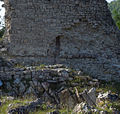
Ascoli Piceno is a comune (municipality) and capital of the province of Ascoli Piceno, in the Italian region of Marche.

The province of Teramo is a province in the Abruzzo region of Italy. Its capital is the city of Teramo. The province has an area of 1,948 square kilometres (752 sq mi), a population of 313,029 (2012), and is subdivided into 47 comuni, see comunes of the province of Teramo. The province of Teramo shares its northern border with the province of Ascoli Piceno in the Marche region, southern and southwestern borders with the province of L'Aquila in the Abruzzo region, and a western border with the province of Rieti in the Lazio region. To the south is the province of Pescara in the Abruzzo region and to the east is the Adriatic Sea.

Frondarola is a small town in the province of Teramo in the Abruzzo region of Italy, population about 200. It lies at an altitude of 1502 feet above sea level and is located about 5 miles from Teramo, of which it is a frazione.

Monti della Laga is a mountain range in the central Apennines of Italy. Their ruggedness and inaccessibility makes them one of the lesser known areas of the Italian peninsula.

Civitella Casanova is an Italian town of inland mountain of 1,950 inhabitants in the province of Pescara in Abruzzo and belongs to the mountain community Vestina. Listed on the National Park of Gran Sasso and Monti della Laga and the Regional Reserve Voltigno and Valle d'Angri, a regional reserve included in the National Park, the country bases its economy mainly on agriculture. It has pre-Roman origins of repute, the sources of the historian Livy emerges as the town of Civitella was called Cutina or Cingilia.

Campli is a town and comune in the province of Teramo, in the Abruzzo region of central Italy. It is located in the natural park known as the Gran Sasso e Monti della Laga National Park. It is one of I Borghi più belli d'Italia.

Civitella del Tronto is a town and comune in the province of Teramo, within the Abruzzo region of central Italy. It is in the Gran Sasso e Monti della Laga National Park. It is one of I Borghi più belli d'Italia.
Colonnella is a comune in the Province of Teramo in the Italian region Abruzzo of eastern Italy. It is part of the Unione dei comuni Città Territorio-Val Vibrata.
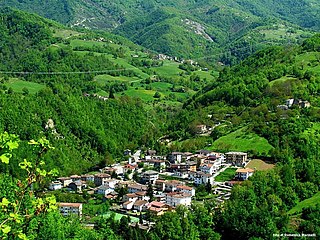
Valle Castellana is a village and comune in the Province of Teramo, in the Abruzzo region of central Italy. It is a member of the Italian community of surrounding mountain villages, Monti della Laga. It is located in the natural park known as the Gran Sasso e Monti della Laga National Park.
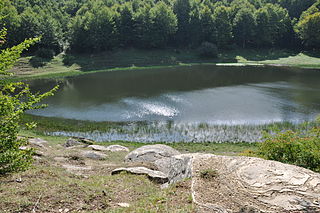
Accumoli is a comune (municipality) in the Province of Rieti in the Italian region of Lazio, located about 110 kilometres (68 mi) northeast of Rome and about 45 kilometres (28 mi) northeast of Rieti. It is located in the natural park known as the "Gran Sasso e Monti della Laga National Park".

The Gran Sasso and Monti della Laga National Park is a natural park in central Italy. Established in 1991, it covers an area of 2,014 square kilometres (778 sq mi), mostly within the provinces of Teramo, L'Aquila, and Pescara in Abruzzo, with small areas in the provinces of Rieti in Lazio and Ascoli Piceno in Marche. The terrain is predominantly mountainous with alpine plains.

The Tronto is a 115-kilometre (71 mi) long Italian river that arises at Monti della Laga and ends in the Adriatic Sea at Porto d'Ascoli, San Benedetto del Tronto. It traverses the Lazio, Marche, and Abruzzo regions of Italy.
Montagna dei Fiori is a mountain group in the Abruzzo, central Italy, forming the Monti Gemelli massif, together with the Montagna di Campli. It is located nearby the boundary between the province of Teramo and the Marche region; due to its proximity to Ascoli Piceno, it is also known as Montagna d'Ascoli.

Tourism in Abruzzo has become one of the most prosperous sectors in the economy of Abruzzo, and in recent years has seen a remarkable growth attracting numerous tourists from Italy and Europe. According to statistics, in 2021 arrivals totaled 1,330,887. A total of 5,197,765 arrivals were tourists, a figure that puts the region seventeenth among the Italian regions for numbers of tourists per year. A moderate support to tourism is also given to the Abruzzo Airport with many low cost and charter flights connecting the entire region with the rest of Europe.
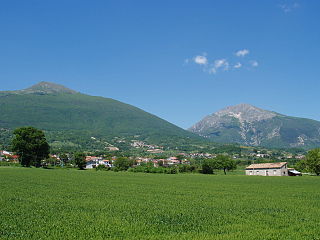
Monti Gemelli is the name given to two similar mountains, Montagna dei Fiori and Montagna di Campli, in the Abruzzo region of Italy. They are located in the Province of Teramo.
Monsampietro is a frazione (hamlet) of the comune (municipality) of Venarotta in the province of Ascoli Piceno in the Italian region Marche. The territory is part of Diocese of Ascoli Piceno.

The Salinello is a river in Italy. It is located in the province of Teramo in the Abruzzo region of southern Italy. The source of the river is in the Monti della Laga range southwest of Montagna dei Fiori. The river flows eastward and curves northeast near Civitella del Tronto. The river then curves southeast near Sant'Egidio alla Vibrata and the border with the province of Ascoli Piceno. Finally, the river flows east near Sant'Omero and enters the Adriatic Sea near Giulianova and Tortoreto Lido.

The Castellano is a river in Italy. Its source is in the Monti della Laga mountains near the border between the province of Teramo and the province of Rieti north of Monte Gorzano. It flows northeast through the mountains in the province of Teramo and eventually forms the border between the province of Teramo and the province of Ascoli Piceno. The river flows west of Monte dei Fiori before entering the province of Ascoli Piceno. The river joins the Tronto at Ascoli Piceno.
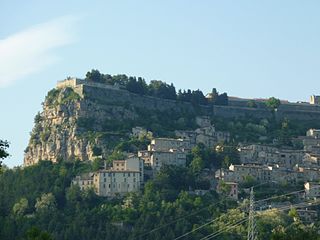
Fortezza di Civitella del Tronto is a fortress in Civitella del Tronto, Province of Teramo (Abruzzo).

The Abbey of Montesanto or Abbazia di Santa Maria in Montesanto is Romanesque-style Benedictine monastery located in the rural hills outside the town of Civitella del Tronto, in the province of Teramo, Abruzzo, Italy.














